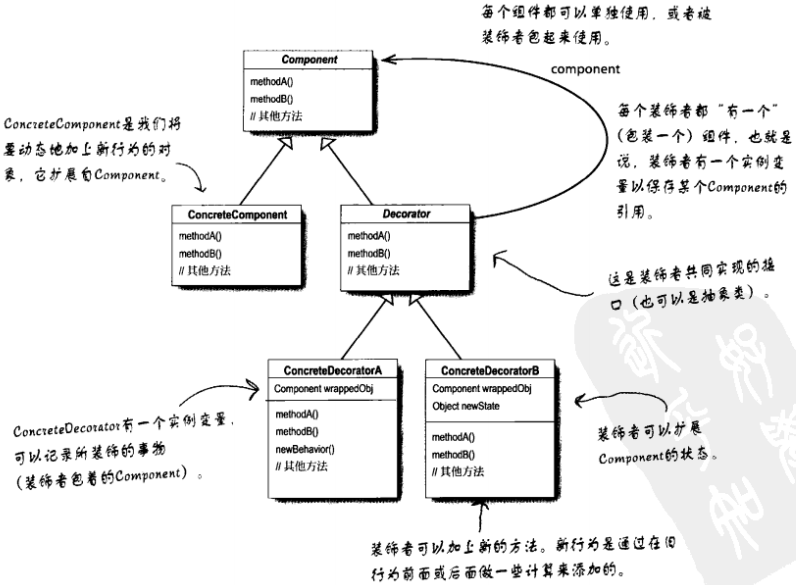设计模式学习笔记之装饰者模式
在装饰模式中的角色有:
抽象构件(Component)角色:给出一个抽象接口,以规范准备接收附加责任的对象。
具体构件(ConcreteComponent)角色:定义一个将要接收附加责任的类。
装饰(Decorator)角色:持有一个构件(Component)对象的实例,并定义一个与抽象构件接口一致的接口。
具体装饰(ConcreteDecorator)角色:负责给构件对象“贴上”附加的责任。

|
/**
* 孙悟空的本尊,并且定义了七十二变的方法。
* 抽象构件(Component)角色
*/
public abstract class Monkey {
protected String type = "本尊";
protected abstract void change();
public String getType() {
return type;
}
}
|
|
/**
* 齐天大圣
* 具体构件(ConcreteComponent)角色
* */
public class MonkeyKing extends Monkey{
public MonkeyKing() {
type = "齐天大圣 -> ";
}
@Override
protected void change() {
System.out.println("七十二变......");
}
}
|
|
/**
* 变化的孙悟空
* 装饰(Decorator)角色
* */
public abstract class ChangeMonkey extends Monkey{
@Override
protected abstract void change();
}
|
|
/**
* 变化后为鱼
* 具体装饰(ConcreteDecorator)角色
* */
public class Fish extends ChangeMonkey{
private Monkey monkey;
public Fish(Monkey monkey) {
this.monkey = monkey;
}
@Override
protected void change() {
System.out.println("变化为 Fish ......");
}
public String getType() {
return monkey.getType() + "fish -> ";
}
}
|
|
/**
* 变化后为鸟
* 具体装饰(ConcreteDecorator)角色
* */
public class Bird extends ChangeMonkey{
private Monkey monkey;
public Bird(Monkey monkey) {
this.monkey = monkey;
}
@Override
protected void change() {
System.out.println("Bird......");
}
public String getType() {
return monkey.getType() + "bird -> ";
}
}
|
|
public class Client {
public static void main(String[] args) {
Monkey monkey = new MonkeyKing();
Monkey fish = new Fish(monkey);
Monkey fish2 = new Fish(fish);
Monkey bird = new Bird(fish2);
System.out.println(bird.getType());
bird.change();
}
}
|
根据上图可以看出:
● 抽象构件(Component)角色:由InputStream扮演。这是一个抽象类,为各种子类型提供统一的接口。
● 具体构件(ConcreteComponent)角色:由ByteArrayInputStream、FileInputStream、PipedInputStream、StringBufferInputStream等类扮演。它们实现了抽象构件角色所规定的接口。
● 抽象装饰(Decorator)角色:由FilterInputStream扮演。它实现了InputStream所规定的接口。
● 具体装饰(ConcreteDecorator)角色:由几个类扮演,分别是BufferedInputStream、DataInputStream以及两个不常用到的类LineNumberInputStream、PushbackInputStream。
(1)装饰模式与继承关系的目的都是要扩展对象的功能,但是装饰模式可以提供比继承更多的灵活性。装饰模式允许系统动态决定“贴上”一个需要的“装饰”,或者除掉一个不需要的“装饰”。继承关系则不同,继承关系是静态的,它在系统运行前就决定了。
(2)通过使用不同的具体装饰类以及这些装饰类的排列组合,设计师可以创造出很多不同行为的组合。
由于使用装饰模式,可以比使用继承关系需要较少数目的类。使用较少的类,当然使设计比较易于进行。但是,在另一方面,使用装饰模式会产生比使用继承关系更多的对象。更多的对象会使得查错变得困难,特别是这些对象看上去都很相像。




